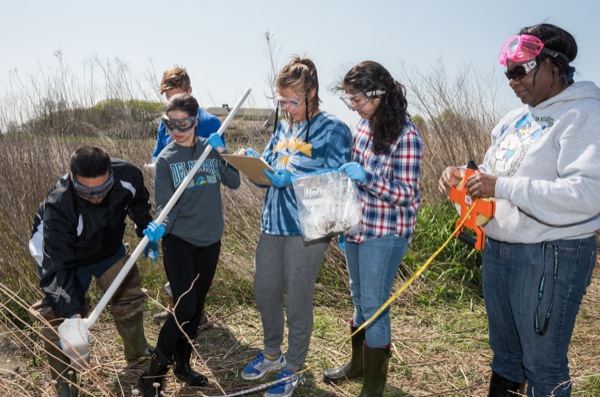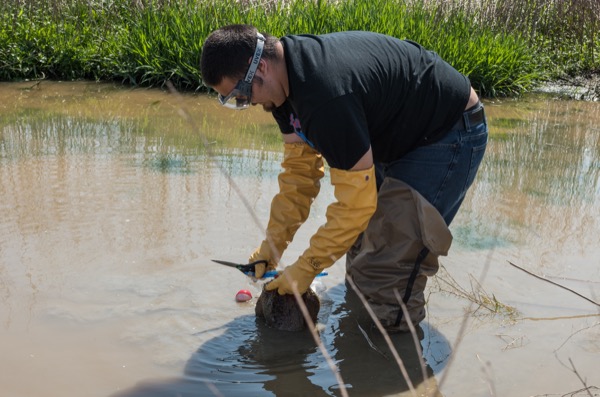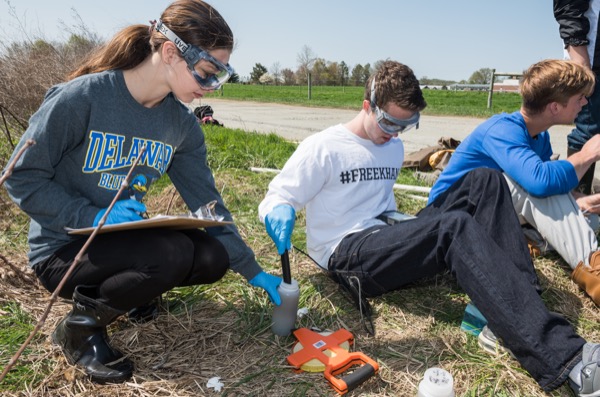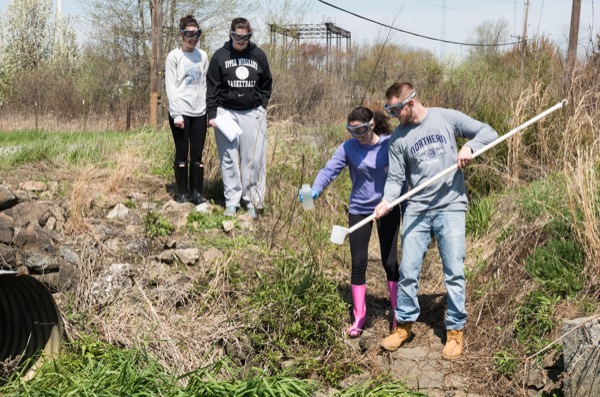Sampling water
Biology, chemistry students team up for analysis of water samples from UD Farm
11:48 a.m., May 1, 2015--University of Delaware biology and chemistry students spent an afternoon down at the farm on Earth Day, April 22, taking water samples from three locations on the South Campus.
After measuring temperature, pH and oxygen levels, they took the water and samples of plant debris back to the Interdisciplinary Science and Engineering Laboratory (ISE Lab) for further analysis.
Campus Stories
From graduates, faculty
Doctoral hooding
As part of a project to investigate water quality, BISC208 students and CHEM104 students teamed up in groups. The ultimate goal of the project was to apply problem-solving skills to determine which water samples from the three locations would best fit a given real-world scenario.
At the end of the semester, the combined biology and chemistry sections will present their findings on e-posters.
This is the second year students have taken water samples from the UD Farm to study the impact of water quality based on chemical and biological tests. Students worked in the lab over three days testing the samples.
During the sessions, biology and chemistry students worked simultaneously in laboratory rooms connected by a middle classroom, each group running different types of tests.
Biology students began by looking at their leaf bag samples. Before spring break, students had placed mesh bags full of leaves in the water at the farm to see what organisms would grow. During their lab, students pulled apart the leaves and looked in petri dishes and microscopes to see which organisms were living on the wet leaves. Students found plenty of snails, beetles and leeches among other small organisms.
At the same time, chemistry students were on the other side testing the water samples for iron and nitrate levels. Students used a spectrophotometer to measure how much of each was present.
While the two classes may have seemed distinct, the amount of overlap between biology and chemistry was an important emphasis of the integrated learning approach in the course objectives, said Gary Laverty, associate professor, and Oyenike Olabisi, assistant professor, both of biological sciences.
The goals of the integrated courses are to give students lab work that has real-world significance and to show the importance of understanding material from both disciplines, Laverty said.
Olabisi said students begin the course seeing biology and chemistry as separate fields of study. “But in our eyes they overlap,” he said. “It gets them to think about it in a different way.”
In addition to the professors, the labs are made possible with the help of preceptors, who bridge the gap between faculty and teaching assistants. A hallmark of ISE Lab, preceptors are resources for students and also maintain coordination between the labs and classes.
Students expressed enthusiasm about the problem-based-learning experience. “Anything that’s more hands-on is better,” said exercise science major Nick Gruwell.
Article by Ashley Heller
Photos by Kathy F. Atkinson














